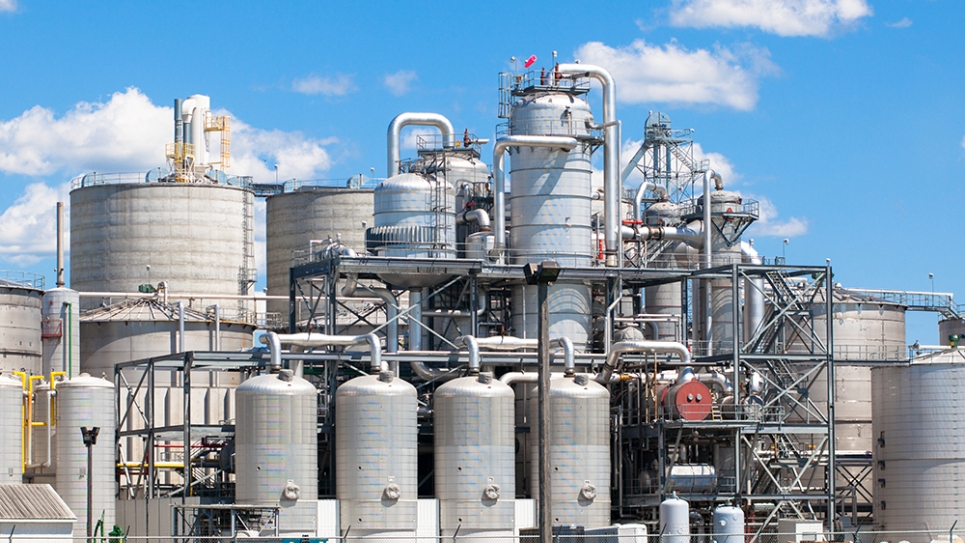
ALCF simulations lead to patented process for biofuel production
Using supercomputers at the Argonne Leadership Computing Facility (ALCF), a team of researchers from the University of Minnesota employed computational screening to identify promising microporous materials, called zeolites, for various biofuel production processes—resulting in a U.S. patent.
The patent, now available for licensing, has been awarded to the researchers—J. Ilja Siepmann, Peng Bai, and Michael Tsapatsis—for their development of unique, zeolite-enabled processes for separating ethanol from water.
Separation of ethanol from water, essential for biofuel production, is usually effected via distillation. The new, patented process—by which ethanol would be preferentially adsorbed from a water mixture through a zeolite-containing adsorbent or membrane—would permit significant energy savings over traditional distillation-based separation.
Siepmann’s team carried out the computational work forming the basis of the patent on the Mira supercomputer under the auspices of a Director’s Discretionary (DD) allocation at the ALCF, a U.S. Department of Energy (DOE) Office of Science User Facility.
Software and workflows designed for mid-level computing clusters needed to be partially rewritten to partition its various tasks across more than 100,000 cores. In doing so, the team demonstrated that the code could be scaled to the whole of Mira for two key steps: the generation of energy grid files (energy calculations completed on a fine grid to be utilized in subsequent simulations) and Monte Carlo simulation runs. Siepmann has since been the recipient of computing time at the ALCF through the DOE Office of Science ASCR Leadership Computing Challenge (ALCC). The ALCC awards are driving the discovery and design of nanoporous materials for energy applications through research that utilizes machine learning, evolutionary algorithms, molecular simulations for high-throughput screening, and high-level electronic structure calculations.
“The number of successful outcomes that have resulted from application development work we did several years ago to scale Ilja’s computational screening code is absolutely amazing to me, and now that effort has even started to yield patents,” said Chris Knight, an Argonne computational scientist who has worked with the team to help optimize their software for ALCF resources. “Enabling new capabilities in large-scale high-performance computing that map directly into creation of real-world industrial applications today is exciting, and even more so when you think about the possibilities soon to be realized by exascale computing.”
For the ethanol purification, the team wanted to find zeolites with a strong affinity for ethanol over water. Because the all-silica zeolites in question are so hydrophobic, the situation becomes extremely opaque: While the zeolites themselves adsorb no water, they do, to a moderate degree, adsorb ethanol. Once a few ethanol molecules have been adsorbed, these ethanol molecules themselves can become a hydrogen-bonding site for water molecules.
“You’re starting from a solution that has maybe 20 to 100 times more water molecules than ethanol molecules,” Siepmann explained. “If then, in the zeolite, each ethanol molecule would bind to one water molecule, you would not have a lot of selectivity. Were you to investigate the adsorption of water and ethanol separately, you would find that all of these zeolites would be high-performing materials—because essentially none of them adsorbs water by itself, and all of them adsorb some amount of ethanol.”
To assess candidates based on a combination of capacity (to reduce the energy costs of desorption) and selectivity (to increase purity with fewer adsorption steps), the computational work Siepmann’s team needed to complete was therefore a matter of large-scale screening: approximately 400 zeolites over a range of solution-phase compositions (ranging from 0.1 to 40 percent ethanol by weight), with each candidate requiring numerous simulations so that meaningful statistics could be collected and subsequently averaged to attain a higher degree of fidelity. The number and parallelism of the involved simulations made the use of a computing system of Mira’s scale appealing.
“To some extent, you could argue that we could have done this study on a smaller computer, but (a) it would have taken much, much longer, and (b) it would have come at the cost of many other projects. So, the allocation at the ALCF really allowed us to tackle a grand challenge application that, frankly, would be unfeasible on a smaller computing system,” Siepmann said. “Without a supercomputer like Mira and a large allocation of computer time, we would have examined far fewer zeolites and may have missed the best-performing ones.”
Argonne National Laboratory seeks solutions to pressing national problems in science and technology. The nation's first national laboratory, Argonne conducts leading-edge basic and applied scientific research in virtually every scientific discipline. Argonne researchers work closely with researchers from hundreds of companies, universities, and federal, state and municipal agencies to help them solve their specific problems, advance America's scientific leadership and prepare the nation for a better future. With employees from more than 60 nations, Argonne is managed by UChicago Argonne, LLC for the U.S. Department of Energy's Office of Science.
The U.S. Department of Energy's Office of Science is the single largest supporter of basic research in the physical sciences in the United States and is working to address some of the most pressing challenges of our time. For more information, visit the Office of Science website.